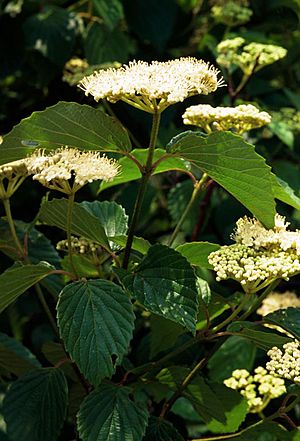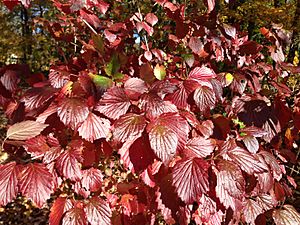Viburnum dentatum facts for kids
Quick facts for kids Viburnum dentatum |
|
|---|---|
 |
|
| Conservation status | |
| Scientific classification | |
| Genus: |
Viburnum
|
| Species: |
dentatum
|
 |
|
| Natural range in North America | |
The Viburnum dentatum, also known as southern arrowwood or arrowwood viburnum, is a small shrub. It grows naturally in the Eastern United States and Canada. You can find it from Maine all the way south to Northern Florida and across to Eastern Texas.
Like other plants in the Viburnum family, this shrub has leaves that grow in pairs on opposite sides of the stem. Its leaves are simple, meaning they are not divided into smaller leaflets. The plant also produces fruits that look like berries, but they are actually a type of fruit called a drupe. In the late fall, the leaves change color from yellow to red, making the plant very pretty.
You might notice that arrowwood viburnum plants can look a little different depending on where they grow. For example, their leaves might be different sizes or shapes. Also, the tiny hairs (called pubescence) on the underside of the leaves and on the leaf stems can vary.
Contents
About the Arrowwood Viburnum
The arrowwood viburnum is an important part of its ecosystem. Many creatures rely on it for food.
Who Eats the Arrowwood Viburnum?
The young forms of moths, called larvae, like to eat the leaves of the Viburnum dentatum. Some specific types of moths that feed on it include the unsated sallow and Phyllonorycter viburnella.
However, there's also an insect called the viburnum leaf beetle (Pyrrhalta viburni) that eats this plant. This beetle is an invasive species, which means it came from another part of the world (Eurasia) and can cause problems for plants here.
The fruits of the arrowwood viburnum are a great food source for songbirds. These berries are very nutritious, with about 41.3% fat!
What Do the Berries Look Like?
The berries of the arrowwood viburnum are a beautiful blue color. This color comes from special natural colors called pigments. The main pigments are cyanidin 3-glucoside, cyanidin 3-sambubioside, and cyanidin 3-vicianoside. However, the mix of all the colors together is quite complex.
Special Uses of the Plant
Long ago, Native Americans used the young, straight stems of the arrowwood viburnum. They would use these stems to make the shafts for their arrows. This is how the plant got its common name, "arrowwood."
Types of Arrowwood Viburnum
There are a few different types, or subspecies, of Viburnum dentatum:
- Viburnum dentatum dentatum
- Viburnum dentatum lucidum - also known as smooth arrowwood
See also
 In Spanish: Viburnum dentatum para niños
In Spanish: Viburnum dentatum para niños



